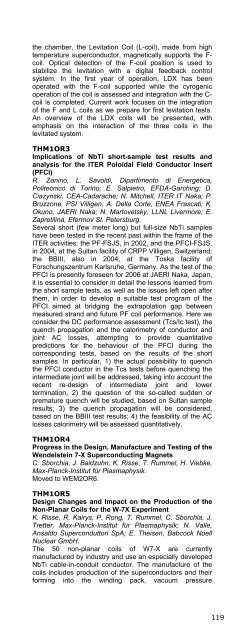Click here to download the abstract booklet in pdf format - MT19 - Infn
Click here to download the abstract booklet in pdf format - MT19 - Infn
Click here to download the abstract booklet in pdf format - MT19 - Infn
Create successful ePaper yourself
Turn your PDF publications into a flip-book with our unique Google optimized e-Paper software.
<strong>the</strong> chamber, <strong>the</strong> Levitation Coil (L-coil), made from high<br />
temperature superconduc<strong>to</strong>r, magnetically supports <strong>the</strong> F-<br />
coil. Optical detection of <strong>the</strong> F-coil position is used <strong>to</strong><br />
stabilize <strong>the</strong> levitation with a digital feedback control<br />
system. In <strong>the</strong> first year of operation, LDX has been<br />
operated with <strong>the</strong> F-coil supported while <strong>the</strong> cyrogenic<br />
operation of <strong>the</strong> coil is assessed and <strong>in</strong>tegration with <strong>the</strong> C-<br />
coil is completed. Current work focuses on <strong>the</strong> <strong>in</strong>tegration<br />
of <strong>the</strong> F and L coils as we prepare for first levitation tests.<br />
An overview of <strong>the</strong> LDX coils will be presented, with<br />
emphasis on <strong>the</strong> <strong>in</strong>teraction of <strong>the</strong> three coils <strong>in</strong> <strong>the</strong><br />
levitated system.<br />
THM1OR3<br />
Implications of NbTi short-sample test results and<br />
analysis for <strong>the</strong> ITER Poloidal Field Conduc<strong>to</strong>r Insert<br />
(PFCI)<br />
R. Zan<strong>in</strong>o, L. Savoldi, Dipartimen<strong>to</strong> di Energetica,<br />
Politecnico di Tor<strong>in</strong>o; E. Salpietro, EFDA-Garch<strong>in</strong>g; D.<br />
Ciazynski, CEA-Cadarache; N. Mitchell, ITER IT Naka; P.<br />
Bruzzone, PSI Villigen; A. Della Corte, ENEA Frascati; K.<br />
Okuno, JAERI Naka; N. Mar<strong>to</strong>vetsky, LLNL Livermore; E.<br />
Zapretil<strong>in</strong>a, Efermov St. Petersburg.<br />
Several short (few meter long) but full-size NbTi samples<br />
have been tested <strong>in</strong> <strong>the</strong> recent past with<strong>in</strong> <strong>the</strong> frame of <strong>the</strong><br />
ITER activities: <strong>the</strong> PF-FSJS, <strong>in</strong> 2002, and <strong>the</strong> PFCI-FSJS,<br />
<strong>in</strong> 2004, at <strong>the</strong> Sultan facility of CRPP Villigen, Switzerland;<br />
<strong>the</strong> BBIII, also <strong>in</strong> 2004, at <strong>the</strong> Toska facility of<br />
Forschungszentrum Karlsruhe, Germany. As <strong>the</strong> test of <strong>the</strong><br />
PFCI is presently foreseen for 2006 at JAERI Naka, Japan,<br />
it is essential <strong>to</strong> consider <strong>in</strong> detail <strong>the</strong> lessons learned from<br />
<strong>the</strong> short sample tests, as well as <strong>the</strong> issues left open after<br />
<strong>the</strong>m, <strong>in</strong> order <strong>to</strong> develop a suitable test program of <strong>the</strong><br />
PFCI aimed at bridg<strong>in</strong>g <strong>the</strong> extrapolation gap between<br />
measured strand and future PF coil performance. Here we<br />
consider <strong>the</strong> DC performance assessment (Tcs/Ic test), <strong>the</strong><br />
quench propagation and <strong>the</strong> calorimetry of conduc<strong>to</strong>r and<br />
jo<strong>in</strong>t AC losses, attempt<strong>in</strong>g <strong>to</strong> provide quantitative<br />
predictions for <strong>the</strong> behaviour of <strong>the</strong> PFCI dur<strong>in</strong>g <strong>the</strong><br />
correspond<strong>in</strong>g tests, based on <strong>the</strong> results of <strong>the</strong> short<br />
samples. In particular, 1) <strong>the</strong> actual possibility <strong>to</strong> quench<br />
<strong>the</strong> PFCI conduc<strong>to</strong>r <strong>in</strong> <strong>the</strong> Tcs tests before quench<strong>in</strong>g <strong>the</strong><br />
<strong>in</strong>termediate jo<strong>in</strong>t will be addressed, tak<strong>in</strong>g <strong>in</strong><strong>to</strong> account <strong>the</strong><br />
recent re-design of <strong>in</strong>termediate jo<strong>in</strong>t and lower<br />
term<strong>in</strong>ation, 2) <strong>the</strong> question of <strong>the</strong> so-called sudden or<br />
premature quench will be studied, based on Sultan sample<br />
results; 3) <strong>the</strong> quench propagation will be considered,<br />
based on <strong>the</strong> BBIII test results; 4) <strong>the</strong> feasibility of <strong>the</strong> AC<br />
losses calorimetry will be assessed quantitatively.<br />
THM1OR4<br />
Progress <strong>in</strong> <strong>the</strong> Design, Manufacture and Test<strong>in</strong>g of <strong>the</strong><br />
Wendelste<strong>in</strong> 7-X Superconduct<strong>in</strong>g Magnets<br />
C. Sborchia, J. Baldzuhn, K. Risse, T. Rummel, H. Viebke,<br />
Max-Planck-Institut für Plasmaphysik.<br />
Moved <strong>to</strong> WEM2OR6.<br />
THM1OR5<br />
Design Changes and Impact on <strong>the</strong> Production of <strong>the</strong><br />
Non-Planar Coils for <strong>the</strong> W-7X Experiment<br />
K. Risse, R. Kairys, P. Rong, T. Rummel, C. Sborchia, J.<br />
Tretter, Max-Planck-Institut für Plasmaphysik; N. Valle,<br />
Ansaldo Supercondut<strong>to</strong>ri SpA; E. Theisen, Babcock Noell<br />
Nuclear GmbH.<br />
The 50 non-planar coils of W7-X are currently<br />
manufactured by <strong>in</strong>dustry and use an especially developed<br />
NbTi cable-<strong>in</strong>-conduit conduc<strong>to</strong>r. The manufacture of <strong>the</strong><br />
coils <strong>in</strong>cludes production of <strong>the</strong> superconduc<strong>to</strong>rs and <strong>the</strong>ir<br />
form<strong>in</strong>g <strong>in</strong><strong>to</strong> <strong>the</strong> w<strong>in</strong>d<strong>in</strong>g pack, vacuum pressure<br />
impregnation of <strong>the</strong> <strong>in</strong>sulation and connection of <strong>the</strong><br />
electrical jo<strong>in</strong>ts with a resistance lower than 1 nOhm. Then,<br />
embedd<strong>in</strong>g <strong>in</strong><strong>to</strong> a cast steel cas<strong>in</strong>g, f<strong>in</strong>al mach<strong>in</strong><strong>in</strong>g,<br />
assembly of <strong>the</strong> helium cool<strong>in</strong>g system and <strong>the</strong> diagnostics<br />
are performed. The coils are cooled by supercritical helium<br />
flow<strong>in</strong>g through <strong>the</strong> conduc<strong>to</strong>rs and <strong>the</strong> cool<strong>in</strong>g systems on<br />
<strong>the</strong> cas<strong>in</strong>g surface. Design changes have been<br />
implemented dur<strong>in</strong>g <strong>the</strong> production <strong>in</strong> <strong>the</strong> connection areas<br />
of <strong>the</strong> cas<strong>in</strong>gs due <strong>to</strong> more detailed design and structural<br />
work. This has required <strong>the</strong> re<strong>in</strong>forcement of welds and remach<strong>in</strong><strong>in</strong>g<br />
of <strong>the</strong> coils while production was already <strong>in</strong><br />
progress. Dur<strong>in</strong>g <strong>the</strong> manufacture some improvements<br />
were required <strong>to</strong> <strong>the</strong> <strong>in</strong>sulation and <strong>the</strong> welds <strong>in</strong> <strong>the</strong><br />
term<strong>in</strong>ation area. New quench detection cables were<br />
qualified. The cas<strong>in</strong>gs have been subjected <strong>to</strong> LINAC<br />
<strong>in</strong>spections and <strong>the</strong> detected defects were repaired. In<br />
order <strong>to</strong> guarantee <strong>the</strong> <strong>in</strong>sulation quality, high voltage tests<br />
<strong>in</strong> vacuum under Paschen-m<strong>in</strong>imum conditions have been<br />
added. This paper will give an overview on <strong>the</strong> status and<br />
schedule of coil fabrication and describe <strong>the</strong> design<br />
changes and improvements <strong>to</strong> <strong>the</strong> manufactur<strong>in</strong>g<br />
techniques.<br />
THM1OR6<br />
Test results of a CICC with advanced Nb3Sn strands,<br />
pro<strong>to</strong>type of <strong>the</strong> fusion dipole conduc<strong>to</strong>r<br />
P. Bruzzone, B. Stepanov, R. Wesche, EPFL-CRPP; A.<br />
Por<strong>to</strong>ne, E. Salpietro, A. Vostner, EFDA-CSU Garch<strong>in</strong>g; A.<br />
della Corte, ENEA.<br />
In <strong>the</strong> scope of <strong>the</strong> design activities for a 12.5 T<br />
superconduct<strong>in</strong>g dipole magnet, a short length of cable-<strong>in</strong>conduit<br />
conduc<strong>to</strong>r with steel jacket was prepared <strong>in</strong> spr<strong>in</strong>g<br />
2005 as a pre-pro<strong>to</strong>type of <strong>the</strong> high field dipole conduc<strong>to</strong>r.<br />
The small, rectangular CICC uses for <strong>the</strong> first time<br />
“advanced” Nb3Sn strands, with jc = 1100A/mm2 at 12T,<br />
4.2K, also planned <strong>to</strong> be used <strong>in</strong> <strong>the</strong> qualification samples<br />
for <strong>the</strong> ITER conduc<strong>to</strong>rs. At CRPP, a hairp<strong>in</strong> sample for<br />
SULTAN has been prepared from <strong>the</strong> short conduc<strong>to</strong>r<br />
length, heat treated and <strong>in</strong>strumented. The test program<br />
<strong>in</strong>cluded pressure drop, ac losses and full dc<br />
characterization before and after cyclic load. To correctly<br />
assess <strong>the</strong> CICC performance, an accurate discussion of<br />
<strong>the</strong> available strand results and scal<strong>in</strong>g law is presented.<br />
Opposite <strong>to</strong> o<strong>the</strong>r sub-size Nb3Sn CICC’s tested <strong>in</strong><br />
SULTAN, <strong>the</strong> performance of <strong>the</strong> pro<strong>to</strong>type dipole<br />
conduc<strong>to</strong>r is roughly <strong>in</strong> l<strong>in</strong>e with <strong>the</strong> strand performance.<br />
PARALLEL SESSION 10:30 – 12:20<br />
(Ponente/Levante room)<br />
ENERGY STORAGE<br />
THM2OR1<br />
Field test<strong>in</strong>g of <strong>the</strong> largest Italian SMES<br />
L. Ot<strong>to</strong>nello, P. Albertelli, P. Ferrari, E. Picco, Ansaldo<br />
Ricerche spa; G. Masciarelli, S. Rossi, Ou<strong>to</strong>kumpu Copper<br />
Superconduc<strong>to</strong>rs Italy spa; L. Mart<strong>in</strong>i, C. P<strong>in</strong>cella, CESI<br />
spa; E. Torello, Electrical Eng<strong>in</strong>eer<strong>in</strong>g Department,<br />
University of Genova; A. Mart<strong>in</strong>olli, ELETTRA, S<strong>in</strong>crotrone<br />
Trieste.<br />
The <strong>in</strong>dustrial pro<strong>to</strong>type of a Superconduct<strong>in</strong>g Magnetic<br />
Energy S<strong>to</strong>rage (SMES), sized <strong>to</strong> deliver 1 MW for 1<br />
second, was designed and constructed as result of a<br />
research project, partly funded by <strong>the</strong> Italian M<strong>in</strong>istry of<br />
Education, University and Research. After successfully<br />
undergo<strong>in</strong>g fac<strong>to</strong>ry test, <strong>the</strong> SMES was erected <strong>in</strong> 2004 at<br />
<strong>the</strong> Elettra Synchrotron Light facility <strong>in</strong> Trieste-I and is t<strong>here</strong><br />
achiev<strong>in</strong>g full operation as protect<strong>in</strong>g device from<br />
119 MT-19 2005, Genova



